The Playing And Notation of The Left Hand - 3
The pictures shows the techniques using the thumb, but the techniques can also be perform using the index,
middle and ring fingers. |
| Click the pictures to view videos. |
|
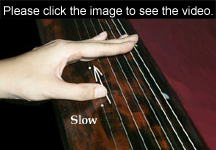 |
Notation:
Name: Taňg 淌
Explanation: Same as "Xià" 下 but the movement of the left hand is slower. It is a slow descending sound. |
|
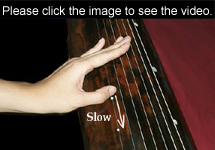 |
Notation:
Name: Tuo (or Tuo Shàng) 拖
Explanation: Same as "Shàng" 上 but the movement of the left hand is slower. It is a slow ascending sound. |
|
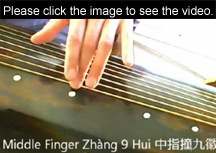 |
Notation:
Name: Zhàng (to strike against) 撞
Explanation: When the left hand presses down a string, and then after the right hand has pulled the string, the left hand moves very quickly up (to the right) about 1/5 - 1/2 portion of to next Hui position, and quickly moves back to the spot indicated. The strength of moving up should be timid and fast and the down moving should be strong, solid and fast as well.
|
|
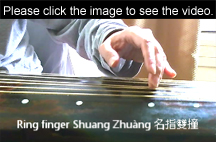 |
Notation:
Name: Shuang Zhàng (to strike against twice) 雙撞
Explanation: Do twice of "Zhuàng." |
|
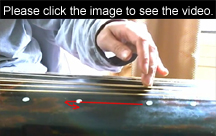 |
Notation:
Name: Xu Zhuàng 虛撞
Explanation: “Xu” literally means “empty, unfilled,” therefore
a “Xu Zhuàng “is to have a Zhuàng technique
happen after a non- plucked sound. For
example, the left hand may do a Zhuàng after
an upward moving technique (Shàng or Jìng ),
or a downward moving technique (Xià or Fù ) or
a vibrato technique (Yín or Náo ) has been
performed.
|
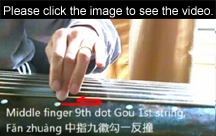 |
Notation:
Name: Fǎn zhuàng (Opposit of Zhuàng) 反撞
Explanation: Same technique as "Zhàng" but moves the left hand very quickly down first (to the left) about 1/5 - 1/2 of to the next "Hui" position and moves back
quickly to the spot indicated. It is like a faster motion of Tuì fù.
|
|
 |
Notation:
Name: Dò 逗
Explanation: While the right hand pulls the string, simultaneously the left hand moves up and back to the hui position quickly. It is similar to Zhuàng 撞, but Zhuàng is done after the right hand pulls the string. |
|
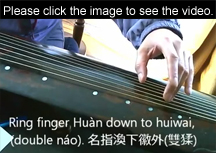 |
Notation:
Name: Huàn 渙, 喚,or 換
Explanation: 宋成玉礀[琴書大全]: 注少許,略作猱, 而復引少許.
Slides down over to the hui position a little bit,
then slightly náo (once or twice), and then
slides up to above the hui position a little bit.
|
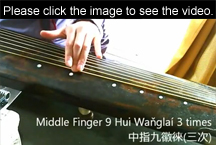 |
Notation:
Name: Waňglaí (back and forth) 往來
Explanation: 往來得聲自上而下三次(或兩次). When a finger of the left hand presses down a string and after the right hand has pulled the string,
the left hand moves down to the next sound position to the left and then moves back to where it started; and repeats this movement
twice or three times to produce a total of 4 or 6 sounds. (ex. 5,3,5,3,5,3).
|
|
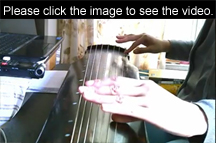 |
Notation:
Name: Fen Kai 分開
Explanation: When a finger of the left hand presses down a string and after the right hand has pulled the string, the left hand glides up to the next Hui position to the right; and then while the right hand pulls the string again, the left hand glides back to where it started, as the action of "Zhù." |
|
|
|